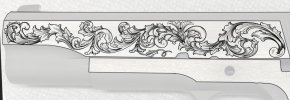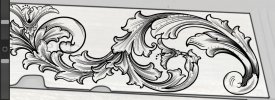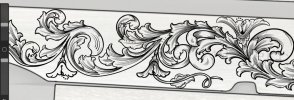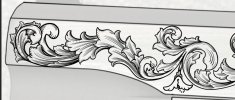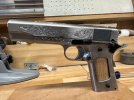You are using an out of date browser. It may not display this or other websites correctly.
You should upgrade or use an alternative browser.
You should upgrade or use an alternative browser.
Critique Request Looking for design critique. Thanks!
- Thread starter Mike576
- Start date
AllenClapp
Elite Cafe Member
(1) It looks like a few of the cuts would run right out into the edge of the slide. This will create a rough place on the edge that will be tough on holsters and clothing. You may wish to consider moving all the elements close to edges back a uniform distance to establish a uniform visual border around the design. (2) It looks like the stem running above the dust cover is growing backwards from the previous scroll. You may want to loop the end of that scroll around the let the stem flow into the rest of the elements above the dust cover. (3) The open spaces between the seed and the first revolution of the seed scroll and between the seed scroll and the second scroll look a little large compared to the other background negative spaces. Adding a leaf outside of the end of those two scrolls would help to reduce those large negative spaces. (4) I like the idea of this design. It looks clean and appears to flow nicely. By eliminating the border, you can put that time into cutting and shading the more intricate design elements. It sounds like a good budgeting choice. Having said that, if the budget would allow, you could add a thin inlaid border of gold around the design [maybe with inlaid gold beads and tendrils and really show it off.
AllenClapp
Elite Cafe Member
Yes. The underlug on the front of the slide that keeps dirt away from the recoil spring.
Rannis
Member
- Joined
- Dec 31, 2022
- Messages
- 65
Dust cover, recoil (action) spring shroud, recoil (action) spring tunnel, they are fairly enterchangable. Not trying to tangent off the original discussion but his terminology is accepted by many 1911 builders.
Not questioning anyone who has not heard of the various terms. There are multiple names for the various parts/areas of the 1911. Barrel Legs and Barrel Lugs seem to be used interchanably. My training used the nomenclature of "legs" for the portion of the barrel which rests on the slide stop, (aka: slide stop pin, or slide catch) and the lugs are on the top of the barrel and engage the slide lugs.
I understand the confusion, Grip panels=Stocks, sear spring( which functions as sear, disconnector, and grip safety spring) Magazine catch(which serves as a trigger stop) and firing pin plate (which serves as extractor retainer), thumb safety serves as grip safety pin as well as its main purpose, the plunger tube spring retains both the magazine catch (slide stop pin) and the thumb safety.
John Browning was pesky in his designing parts which served multiple functions.....Im sure he is looking down with a big smile at our conversation right now.
Very Respectfully, Dale
Not questioning anyone who has not heard of the various terms. There are multiple names for the various parts/areas of the 1911. Barrel Legs and Barrel Lugs seem to be used interchanably. My training used the nomenclature of "legs" for the portion of the barrel which rests on the slide stop, (aka: slide stop pin, or slide catch) and the lugs are on the top of the barrel and engage the slide lugs.
I understand the confusion, Grip panels=Stocks, sear spring( which functions as sear, disconnector, and grip safety spring) Magazine catch(which serves as a trigger stop) and firing pin plate (which serves as extractor retainer), thumb safety serves as grip safety pin as well as its main purpose, the plunger tube spring retains both the magazine catch (slide stop pin) and the thumb safety.
John Browning was pesky in his designing parts which served multiple functions.....Im sure he is looking down with a big smile at our conversation right now.
Very Respectfully, Dale
Rannis
Member
- Joined
- Dec 31, 2022
- Messages
- 65
As an example of what I was refering to in looking front heavy. The picture I am attaching is of my most recent project I am building. The engraving was done by another, it is not my work. But you will notice the negative space to the front of the slide flat nicely balances the negative space behind the cocking serrations.
In my opinion this is a better balance. Not that your design is bad, it is however out of balance I believe.
In my opinion this is a better balance. Not that your design is bad, it is however out of balance I believe.
Attachments
Thanks for the input! I fully agree with you on the balance. I had not designed anything yet for the small section behind the serrations. I plan to do full coverage on this gun including the frame. This design is sort of a work in progress to get input on how it’s going overall since I’m pretty new still to drawing. I should have specified that from the start sorry! I do plan to engrave that area in a design which matches the main area shown.As an example of what I was refering to in looking front heavy. The picture I am attaching is of my most recent project I am building. The engraving was done by another, it is not my work. But you will notice the negative space to the front of the slide flat nicely balances the negative space behind the cocking serrations.
In my opinion this is a better balance. Not that your design is bad, it is however out of balance I believe.
That’s a beautiful 1911 you have by the way!
Thanks also for clearing the air on the nomenclature, i myself didn’t know that either.
Carried one in the Army, got 3 of em all .45acp. just a new term to me.Dust cover, recoil (action) spring shroud, recoil (action) spring tunnel, they are fairly enterchangable. Not trying to tangent off the original discussion but his terminology is accepted by many 1911 builders.
Not questioning anyone who has not heard of the various terms. There are multiple names for the various parts/areas of the 1911. Barrel Legs and Barrel Lugs seem to be used interchanably. My training used the nomenclature of "legs" for the portion of the barrel which rests on the slide stop, (aka: slide stop pin, or slide catch) and the lugs are on the top of the barrel and engage the slide lugs.
I understand the confusion, Grip panels=Stocks, sear spring( which functions as sear, disconnector, and grip safety spring) Magazine catch(which serves as a trigger stop) and firing pin plate (which serves as extractor retainer), thumb safety serves as grip safety pin as well as its main purpose, the plunger tube spring retains both the magazine catch (slide stop pin) and the thumb safety.
John Browning was pesky in his designing parts which served multiple functions.....Im sure he is looking down with a big smile at our conversation right now.
Very Respectfully, Dale
Rannis
Member
- Joined
- Dec 31, 2022
- Messages
- 65
No problem. Ive been building 1911s for about 12 years. Having trained under Bob Marvel, he would beat into my head the various terms. Now, I have just begun studying engraving seriously, and balance was beat into my head by my first instructor Jessie Houser. I certainly wasnt trying to sharp shoot, just give my opinion and I am greatful you took it as such. If you balance the slide I am sure it will be great (along with incorporating the rest of the input from people here). The 1911 is a commemorative for a fund raiser. Thank you for the compliment but I merely built the pistol, Jim Downing, the engraver deserves your praise.Thanks for the input! I fully agree with you on the balance. I had not designed anything yet for the small section behind the serrations. I plan to do full coverage on this gun including the frame. This design is sort of a work in progress to get input on how it’s going overall since I’m pretty new still to drawing. I should have specified that from the start sorry! I do plan to engrave that area in a design which matches the main area shown.
That’s a beautiful 1911 you have by the way!
Thanks also for clearing the air on the nomenclature, i myself didn’t know that either.
V/R Dale
Allen, thanks for lending the keen eye! I hadn’t noticed until now that scroll above the dust cover, seems obvious now that it’s been pointed out. I’ll have a go at reworking this section to make it flow better with the rest of the design. At times while drawing I feel the design is more just happening and less that I’m controlling the design if that makes any sense. Maybe that’s the creative process at work or maybe that just a lack of skill; I’m still deciding! Im glad you like the overall flow of the piece other than this one area though.(1) It looks like a few of the cuts would run right out into the edge of the slide. This will create a rough place on the edge that will be tough on holsters and clothing. You may wish to consider moving all the elements close to edges back a uniform distance to establish a uniform visual border around the design. (2) It looks like the stem running above the dust cover is growing backwards from the previous scroll. You may want to loop the end of that scroll around the let the stem flow into the rest of the elements above the dust cover. (3) The open spaces between the seed and the first revolution of the seed scroll and between the seed scroll and the second scroll look a little large compared to the other background negative spaces. Adding a leaf outside of the end of those two scrolls would help to reduce those large negative spaces. (4) I like the idea of this design. It looks clean and appears to flow nicely. By eliminating the border, you can put that time into cutting and shading the more intricate design elements. It sounds like a good budgeting choice. Having said that, if the budget would allow, you could add a thin inlaid border of gold around the design [maybe with inlaid gold beads and tendrils and really show it off.
As for the budget, there is no set budget for this gun. I’m not some oil tycoon but this will be my first handgun engraved. I have engraved many necklace pendants, knives, watches, tools etc. I believe engraving skill wise i am ready for a bigger challenge. To challenge myself I purchased a nice smith and Wesson 1911 millspec stainless. I plan to work on this design until I’m happy enough to dedicate myself to the completion of the piece no matter how many hours it takes. The gun will act as both an ice breaker to the gun engraving world, and a major showpiece. This being the rough draft design I will work a border into the rework and see how i like it. I see how this would act to frame the piece and tie things together.
As for the gold tendrils do you mean gold sections to the scrollwork itself? I think this would look nice however would require careful balance to keep from looking to gaudy.
As for the design going outside or very very near the edge in some areas chalk that up to a lack attention since I knew this would be a rough draft requiring revision. I do see what you mean and you’re defiantly right about that resulting in a rough edge! I think a nice border may tidy things up a bit.
Thanks again for all the advise and I will make sure to post my revision once it’s done!
Rannis
Member
- Joined
- Dec 31, 2022
- Messages
- 65
That means you served prior to 1983. Many arguements are made regarding the adoption of the M9 over the 1911. I can see merit in both camps, but the fact that the SO community held on to it lends some credit to the caliber at a minimum.Carried one in the Army, got 3 of em all .45acp. just a new term to me.
I wasnt trying to single you out as you have provided valued insight to me previously. We all converge here from distinctly different backgrounds, and "cross-pollinating" as the Plans/Operations community calls it is vastly valuable.
V/R Dale
Yep , way before 1983. Back in the M-14 days. I know lots of guys that shoot 1911’s. All in acp w/ target load.
I been looking at Mikes design, for me it’s a little too busy For that pistol Imho. Artwork very good/ excellent. I guess the customer decides Ultimately.
I been looking at Mikes design, for me it’s a little too busy For that pistol Imho. Artwork very good/ excellent. I guess the customer decides Ultimately.
Rannis
Member
- Joined
- Dec 31, 2022
- Messages
- 65
On another note. I posted earlier this month regarding a source of unfinished 1911 slide casting for less than 20 bucks. I will run and link here:
They cut nicely.
V/R Dale


